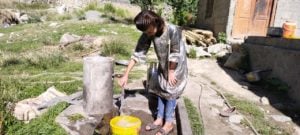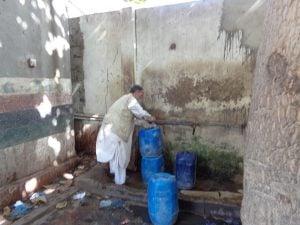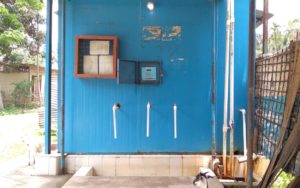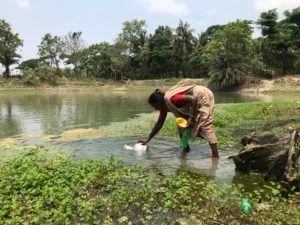Gilgit-Baltistan occupies a crucial position in the supply of water to the whole of Pakistan. The region hosts around 7,000 glaciers, which provide a major source of meltwater into the Indus basin, on which Pakistan is critically dependent. Yet most people living in the lightly populated mountainous region rely on mostly unfiltered water from snowmelt runoff, springs, groundwater and rivers for drinking, leaving them at risk of disease.
A report by the Pakistan Council of Research in Water Resources (PCRWR) in collaboration with the Asia Foundation confirmed just how polluted drinking water is in the region. Out of 94 samples, 10-15 from each of the six districts in Gilgit-Baltistan, PCRWR found that only 22% fell within safe limits for human consumption in terms of contamination.
22%
Samples of drinking water tested that fell within safe limits for human consumption
Most of the samples were collected from taps that drew water from a range of water sources, including surface water channels (28 of the 94 samples), springs (56), groundwater (seven), and rivers or lakes (three).
The biggest issue identified was microbial contamination (found in 68% of samples), followed by turbidity, or cloudiness of water due to undissolved substances (19%), and by the presence of iron (24%), aluminium (7%) and fluoride (2%).
The report suggests likely sources for these contaminants, noting that most microbial contamination was likely a result of sewage mixing with the water supply. The report states that turbidity in water originating from snow and glacier melt is due to “rock flour and other small soil particles that mix with the water while flowing down from the mountains”.
The authors suggest that the presence of iron and aluminium may be due to wastewater from mining, one of the main industries in Gilgit-Baltistan, noting that more research is needed on the impacts of mining. Another explanation for the presence of iron may be rusty taps or pipes.
One hundred per cent of samples tested from rivers were found to be contaminated. This figure was 82% for snowfall runoff in surface water channels and 80% for fresh spring water.
Only 29% of groundwater samples were contaminated. But given the plentiful streams and rivers, and the cost and difficulty of accessing groundwater, this is used far less as a source of water by the people of Gilgit-Baltistan, the report states.
Serious impacts on residents’ health
Residents of Gilgit-Baltistan bear a heavy cost from water pollution. Muhammad Nasir, a retired soldier living in Ghakuch city, Gilgit-Baltistan, recently sent his 11-year-old daughter Naveeda to the Aga Khan hospital in Karachi for medical treatment, about 2,000 kilometres away. The young girl had developed a liver infection at the age of seven due to contaminated drinking water in Ghakuch. Waterborne diseases among children in the city are common, Nasir told The Third Pole.
As treatment facilities in Gilgit-Baltistan are limited, a doctor advised the family to send Naveeda to Karachi when the pain became too acute. She stayed with Nasir’s family in Karachi during treatment, he explained.
We often receive patients with Hepatitis A, typhoid, stomach disorders, diarrhoea or related ailments. This is mostly due to using contaminated water.Muhammad Akhter, doctor in Ghizer
Drinking contaminated water can lead to serious diseases such as cholera, typhoid and Hepatitis A and C, said Karim Khan, a doctor at the district headquarters hospital in Gilgit city. Over the long term, unsafe water can also affect the kidneys and may even lead to cancer if elements like arsenic are present, he added. Khan said he felt that Gilgit-Baltistan was still better off than the downstream provinces of Sindh and Punjab.
Muhammad Akhter, a doctor from Ghizer who also practices in Gilgit city said that waterborne diseases are common in the area. “We often receive patients with Hepatitis A, typhoid, stomach disorders, diarrhoea or related ailments. This is mostly due to using contaminated water,” said Akhter.
Basic drinking water infrastructure missing in the Himalayas
The prevalence of microbes in drinking water points to an overarching problem for communities living in the region: a lack of adequate infrastructure.
Saiqa Imran, a senior researcher at PCRWR who was involved in testing for the report, said that in major cities in the region such as Gilgit, Skardu, Ghakuch and Hunza there is no waste treatment plant or proper sewerage system. Waste water flows directly into rivers. “The degree of water contamination varies from area to area, but the major cities [have a] high degree of contamination,” she said. “Human and animal activities both are responsible for the contamination of drinking water.”
Water may become contaminated by microbes when adequate distance is not maintained between sewage disposal and the water source. Leaky pipes can also lead to sewage seeping into the piping. Most people in Gilgit-Baltistan do not have any access to proper filtration or disinfection.
Imran added that at the original sources of the water – whether glaciers, streams or springs – there was little contamination, but that was not the point at which people get their water. The water is usually collected from taps, having travelled through pipes. “There is proper need [for a] water supply system with effective regular quality monitoring to ensure clean drinking water at the consumer end,” she said.
Contaminated water mostly affects the poor segment of the societyKarim Khan, doctor in Gilgit
During the research, Imran found that in most of the water sources, even chlorine – the cheapest and most common form of water disinfectant in South Asia – had never been used.
Karim Khan highlighted the class divide that marks access to clean water. “Contaminated water mostly affects the poor segment of the society as they cannot afford to buy bottled water nor do they have conveyance facilities to bring it from far-flung areas where clean water is available,” Khan said. “Those citizens who are directly using river water in town areas are most [often at risk from] unsafe water.”
The lack of infrastructure for safe drinking water in Gilgit-Baltistan is ironic, as the China-Pakistan Economic Corridor (CPEC) – Pakistan’s largest infrastructure project – winds through the area.
This problem is by no means isolated to Gilgit-Baltistan, but is endemic in the Himalayan region. Peshawar, the capital city of the neighbouring Pakistani province of Khyber-Pakhtunkhwa, has a major waste-disposal problem, as do cities across Kashmir, Kathmandu in Nepal and Thimphu in Bhutan.
Some anecdotal evidence, more research needed, say officials
Khadim Hussain, deputy director at the Environmental Protection Agency (EPA) Gilgit-Baltistan, said that on the EPA’s recommendations, the provincial government has addressed issues relating to clean drinking water mainly in urban areas, such as regularly cleaning water-supply tanks, installing filtration and fixing leaking pipes to ensure that contaminated water does not mix with the drinking supply. Due to population density it was the urban areas that were most often affected, but the government did step in to deal with these issues from time to time. “The situation is much better than in the past,” he said.
Hussain also criticised the procedure used for sampling water for the report. He said the researchers should have taken samples from sources that are regularly used by the communities for drinking water, rather than taking random samples from different sources. He also suggested that samples from different seasons should have been assessed, and that the researchers should have sought input from local experts and laboratories established by the provincial Local Government and Rural Development (LGRD) department, which has the mandate to address civic issues such as water, sanitation, and streets.
In response, Saiqa Imran of PCRWR said that they had followed all the standard procedures and protocols for testing water quality in Pakistan, and that their samples were taken from where communities get water for drinking. She stated that the report was a one-time assessment to ascertain overall water conditions, rather than a regular monitoring programme, hence why they took samples randomly from different sources.
Commenting on the PCRWR report, Alam Noor Haider, media coordinator to the chief minister of Gilgit-Baltistan, said that it was published during the tenure of the previous government. Haider said that the incumbent provincial government has taken steps to address the issues highlighted, including establishing a sewerage plant in Gilgit city and providing various drinking water schemes in different localities. “Issues are there, but these issues would be fixed during the tenure of Pakistan Tekreek-e-Isaf (PTI) provincial government,” he said. The PTI, which is also the government at the federal level, won elections in Gilgit-Baltistan for the first time in 2020.
Solutions available for safe drinking water in Pakistan
As the report notes, the challenge of water contamination in Gilgit-Baltistan will become more visible as projects linked to the China-Pakistan Economic Corridor go online. The huge project has the potential to make things worse – as construction could impact water quality – or better, if provisions for water sanitation and filtration are included. This will depend on how much the concerns of locals are incorporated into the projects.
The report’s recommendations include provision of better waste infrastructure and disinfection, along with improved testing and education around safe water use.
Where interventions are made with local concerns in mind, they can have quick and impressive results. Hassan Panah, a medical practitioner in Yasin valley, Ghizer district, said that the rate of waterborne diseases in the area drastically reduced after provision of a clean drinking water supply system by the Aga Khan Development Network (AKDN) in some areas of Gilgit-Baltistan and Chitral since 2010.
In a 2015 press release, the AKDN stated that the project – a partnership with the German government, the governments of Gilgit-Baltistan and Khyber-Pakhtunkwa, and local communities – had installed more than 12,000 household tap stands and 500 communal taps, providing drinking water to over 200,000 people.
“The rate of diarrhoea, typhoid, as well as Hepatitis A, particularly among the children reduced to a great extent,” said Panah.




![Woman carrying water from Karakul Lake in Tajikistan [Image by: Alamy]](https://www.thethirdpole.net/content/uploads/2020/09/Tajikistan-water-shortage-story-featured-image-alamy-woman-carrying-water-from-Karakul-Lake-300x201.jpg)